Wildlife tourism is viewed as a mode of protecting our wildplaces. The monetary benefits accruing out of wildlife tourism is used to justify spending on creation and maintenance of wildlife sanctuaries and National Parks by the Government in various developing countries. The argument is that wildlife tourism is a non-consumptive activity i.e. the tourists can�t remove any thing from the area and it doesn�t have any long term impact. It is said that Wildlife Tourism doesn�t consume our scarce resources and it will bring the much needed funds for sustaining our wild places and providing livelihoods for the communities around our National Parks, Wildlife Sanctuaries and Protected Areas. If this were true, then it would have been an easy solution. The tourism sector propagates such myths and the unsuspecting public are more than happy to adopt such an easy route. However, Wildlife Tourism is not the panacea of all ills. Recent research on various species around the world suggests that the harmful effects of tourism are much more significant than earlier estimations.
Let us first try to examine the validity of the basic premises of Wildlife Tourism:
a)non-consumptive and its longterm impact as negligible
b)providing livelihoods for the local communities
Let us look at our wild areas in India. Typically, there were small hamlets or villages around our wildlife places. Once a place is �discovered� by people, someone starts a hotel and few people visit that place. These tourists come back with nice experiences and then hordes of tourist descend on that place. When the tourist traffic increases, entrepreneurs move in to encash on the popularity of that place. And the so called development of that place starts. Unfortunately.
When a wildlife sanctuary or a protected area is opened up for tourism, lot of infrastructure is created in that place. The Hotel owners come from the other areas to set up hotels. The local people don�t have the capability to invest in infrastructure. The local people don’t even qualify to become chefs or cooks in the hotel, as the right kind of culinary skills for serving the well heeled tourists is to be sourced from outside the locality. People from outside the locality again come and invest in vehicles for transporting tourists and in four wheeled vehicles for Safari inside the jungle. Similarly, telephone booths, cyber cafes, massage centres, grocery stores etc come up. The locals are only employed as gardener to maintain the lawns of the hotels or for cleaning utensils or for other menial jobs.
In the initial wave of development, the locals sell off their land. However, in a couple of year�s time, the price of land multiplies and naturally the locals who had bailed out by selling their lands in the initial phase don’t get the fruits of the actual economic boom.�A lot of economic activity happens, but the local communities don�t benefit from it.
This proves that local communities don�t benefit from the wildlife tourism.
Impact:
Does any one think whether a place, once a pristine wilderness area, has the capacity to cater to the huge tourist traffic?
The tourists come in hordes and place huge demands on the environment. To cater to the tourists, hotels are setup with Air Conditioners guzzling lot of energy. Swimming pools are setup and it places a huge demand on the fresh water. Exotic fruits and food supplies need to be transported for the tourists. Migration of people from other areas start. Someone needs to grow vegetables, cereals etc so lot of forest areas give way to cultivation. Similarly the goats for the meat requirements and cattle for the milk or cultivation requirements now fight with the wildlife for grazing space and freshwater needs. And with the livestock comes the attendant problems of the wild animals contracting diseases like foot and mouth, or carnivores killing livestock and then inturn being killed by the people. In a few years time, a hamlet grows into a town. A live example is Bandhavgarh National Park. The Tala village used to be a hamlet with about 8 huts. Now it is growing into a town. People have come to get jobs as guides, drivers, cooks, and have set up restaurants, hotels, grocery shops, wine shops, massage centres etc etc�the list is endless. Similarly, Masinagudi or the Segur Ghats area used to be a pristine wild habitat, till the influx of construction workers for the Moyar and Singara irrigation projects started changing the scenario. With the increase in wildlife tourism, the Masinagudi hamlet is converting into a town. The tribals � the original inhabitants of that area � now number about 600 as opposed to the total population of 15000.
With the increase in tourist traffic, comes the sad spectre of wild animals hit by speeding vehicles. In case of Bandhavgarh National Park, the forest department has now fenced the areas bordering the road and villages. There are cases of poaching by villagers. A tiger was also reported to be electrocuted. The numbers of village dogs has increased, and cases of deer being killed by the village dogs are often reported.

Impact on Wildlife:
The transformation of a sleepy hamlet into a bustling town, has tremendous impact on wildife. Our wildlife don’t have inviolate spaces to roam freely. Most of the times a highway or a train line cuts across the forest and the animals are killed by speeding trains or vehicles. Or people encroach on pristine wildlife habitats, reducing the areas available to the wildlife. The migratory path of the elephants are cut off by high speed canals, or highways. Poachers arrive with their sophisticated weapons, spot lights, jeeps etc and the wildlife simply stands no chance.
In Tala village near Bandhavgarh National Park, a tigress was hit by a speeding vehicle and its jaw was broken. Recently, near Corbett National Park, a tiger was mowed down by a tourist bus. Elephants are regularly mowed down by trains. The animals have become cautious in crossing the road. I saw a tusker look at left and then the right side and crossed the hurriedly cross the road in Nagarhole National Park. I have seen deers, gaurs and other animals running across the road to avoid being hit. But that is not enough. The top speeds of our vehicles make it impossible for the wildlife to dodge the traffic.
Elsewhere, there have been reports of corals getting bleached due to the sunscreen lotion used by divers. No studies have been commissioned to examine the impact of tourism on our marine ecosystem. In the absence of data, everything is expected to be ok.
We don’t realise that when we enter into the forest, whether on vehicles or on foot, we come in contact with animals. With each contact, we leave a lasting impression on the animals.
So the basic premise of Wildlife tourism as non-consumptive and without any longterm impact is a huge lie.
In India, in any forest or National Park, you can find a dilapidated temple. With wildlife tourism, people start visiting these temples or �sacred trees� etc. Soon people start flocking such places expecting miracle cures. That puts a lot of stress on the wild areas. In most of the cases, it is the tour operates who schedule such temple visits to widen their appeal to tourists. In Sariska, it is estimated that about one lakh pilgrims visited the temple in Pandupole on one day. In Bandhavgarh National Park, the park authorities created concrete structures around Sheshsaiya � a 32 feet sculpture of Lord Vishnu � to attract religious tourists.
Can our wildplaces survive such an onslaught?
A study conducted by University of California along with San-Franscisco based Wilderness Society reports significant drop in numbers of carnivores like Bobcats and Coyotes due to tourism.
Too often I have found that it is the tourism sector which propagates such myths of Tourism bringing much needed revenue to the villagers etc etc.
- Canon Launches Cine Servo 11-55 mm T2.95-3.95 lens - 10 September,2025
- Water Monitor Lizard in Sundarbans - 14 May,2025
- Radio collared Tigress - 30 January,2025

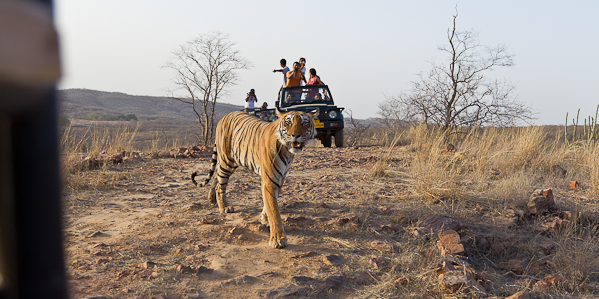
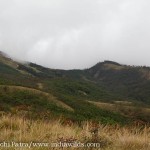
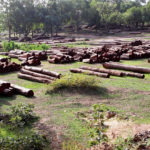
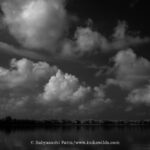


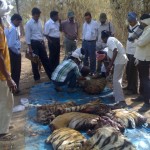
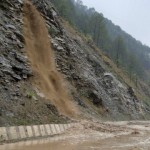



I agree with quite a few points here…. the hotels/cyber cafes/ etc etc built by slashing away at the forest cover leaves much to be desired… specially since the locals are the once who are LEAST benefitted….
on the other hand, tourism brings in much required tourists… and India, with our massive store house of incredible offerings, needs to cash in on the tourism aspect…
Its a catch 22 situation:
is there any way that tourism can be promoted without ruining the core characteristics of the area….??? there must be some way…
the locals should pitch in, in trying to maintain the areas, with the forests and wild life.
it is their land/heritage. some NGO or any organisations going in to create awareness amongst NOT the URBAN population, but the RURAL areas about the vast opportunities lying out there without ruining the essence of the area….
progress is essential… but so is maintaining the heritage…
what is the way forward…??/
Nice post.
I completely agree with chit chat. A little education and pondering over sustainable tourism is the way!
Extremely nice article, loved the analysis every bit.
Of course, very true. Everything has its consequences and the actual person in profit of development are always the one with money in hand not the locals around the region. My friends have witnessed pathetic acts of so called protectors or caretakers and safari guys who circle the tigers around just to let tourist see them in Ranthambhore. It is such a a pitty thing to control freedom of poor animals and bake your extra money for such efforts. I guess it must be practice in many of the parks as well, just to make extra money.
moreover, the loot of innocent tourist for example in the much developed Jim corbett is on full fervour by making those pug marks themselves and maintaining the interest of tourists all day long…
You have written well on a subject that is close to my heart as well. Some of my friends recently went on a wildlife safari and when they came back they spoke about if their presence had negatively impacted the wildlife and decided not to repeat it. The point is as long as humans are involved, no wildlife is ever safe becaoz we dont understand the concept of harmony.
I agree with you 100% … we are actually encroaching into the animals space with wildlife tourism. A great post …
Hi
What a wonderful and thoughtprovoking post. In what ways can people like us prevent this from happening? For now I will share this on Facebook so that others become aware and atleast stop from flocking at these places.
Amazing photo the tiger. Its a difficult one to say if its a boon or bane. Its a double edged sword really.
What a comprehensive analysis of the so-called “eco-tourism” in the country. Absolutely true that in the name of tourism many a wild life sanctuary is being destroyed and its widlife perishing. There is no hope for wild life in this country
Usually I never comment on blogs but your article is so convincing that I never stop myself to say something about it. You’re doing a great job Man,Keep it up.